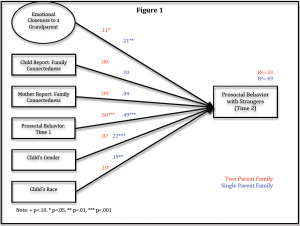Jami Jackson and Dr. Jeremy Yorgason, School of Family Life
Grandparental emotional closeness is important for both grandparents and grandchildren (e.g. Bowers & Myers, 1999; Drew & Silverstein, 2007; Crosnoe & Elder, 2002). However, in many of the studies given, the measure of intergenerational closeness has come from the grandparent (e.g. Fingerman, 2004; Drew & Silverstein, 2007). In cases where the measure has come from the perspective of the grandchild, much of the data have been collected from college‐aged young adults (Dubas, 2001; Harwood, 2001). The purpose of this study is to measure adolescents’ reports of emotional closeness to a grandparent, and to study the relationship between grandparental closeness and adolescents’ prosocial behavior with strangers.
Participants for this study came from Time 1 and Time 2 of the Flourishing Families Project. The Flourishing Families Project is a study of family life that involves families with a child between the ages of 10 and 14 at Time 1. 500 families participated in Time 1, and 95% of that sample (N=473) was retained for Time 2. Factor loadings for the model were all above .55, and reliability was also high (Alpha=.85).
Measures of grandparental closeness, family connectedness, and prosocial behavior toward strangers were taken from the Flourishing Families questionnaire. Family connectedness was taken from the child and Parent 1 at Time 2, and the child’s reports of each parent were combined into one item. Prosocial behavior was assessed by measuring the child’s report of kindness and generosity towards others (e.g. I enjoy doing small favors for others, I help other kids at school), and five questions were used to assess emotional closeness to a specified grandparent (e.g. I feel emotionally close to this grandparent, I communicate with this grandparent).
A structural equation model was used to assess emotional closeness with a grandparent on prosocial behavior. As seen in Figure 1, emotional closeness to a grandparent and adolescents’ prosocial behavior with strangers have a significant relationship that is stronger for children in single parent families. In addition, prosocial behavior measured in Time 1 has a significant relationship with the same construct measured in Time 2. In single parent families, Time 1 prosocial behavior, and the gender and race of the child are significant with Time 2 prosocial behavior.
Although the grandparental role has significance for children in single and two parent families, results from this study indicate that emotional closeness to a grandparent has a stronger link to prosocial behavior for children in single parent families. In single parent families, the child’s gender and race is also significant in affecting prosocial behavior. In fact, females do better than males in terms of prosocial behavior, and gender is almost as influential as grandparent closeness.
The purpose of this study was to measure emotional closeness to a grandparent and determine its relationship to adolescent outcomes such as prosocial behavior with strangers. There is a significant relationship between the two above and beyond parental influences. This shows the importance that grandparents play in the lives of adolescents. Although family connectedness may be positively reported by the adolescent and Parent 1, grandparents do matter in the development of positive outcomes in children, and thus it is important for parents to facilitate closeness between grandparents and grandchildren.

References
- Bowers, B. F., & Myers, B. J. (1999). Grandmothers providing care for grandchildren: Consequences of various levels of caregiving. Family Relations, 48, 303‐311.
- Crosnoe, R., & Elder, Jr. G. H. (2002). Life course transitions, the generational stake, and grandparent‐grandchild relationships. Journal of Marriage and Family, 64, 1089‐1096.
- Drew, L.M., & Silverstein, M. (2007). Grandparents’ psychological well‐being after loss of contact with their grandchildren. Journal of Family Psychology, 21, 372‐379.
- Dubas, J.S. (2001). How gender moderates the grandparent‐grandchild relationship: A comparison of kin‐keeper and kinselector theories. Journal of Family Issues, 22, 478‐492.
- Fingerman, K.L. (2004). The role of offspring and in‐laws in grandparents’ ties to their grandchildren. Journal of Family Issues, 25, 1026‐1049.
